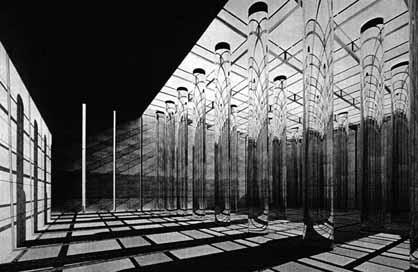|
|
||||||
| image | activities | contacts | links | italiano | ||||||
|
5th
International Festival for Architecture in Video |
||||||
|
introduction program - dates - authors - works - exhibitions partners credits previous editions mailto |
 Takehiko Nagakura The Danteum of Giuseppe Terragni and Pietro Lingeri (1938) Massachusetts Institute of Technology USA 1998, 5'46" The "Danteum" should have been a building designed in 1938 by two eminent Italian architects, Giuseppe Terragni and Pietro Lingeri. Today, it is well known for the allegoric organisation of space following Dante's Divine Comedy. Because of Mussolini's decline during World War II, the project has never been realised and thus has become one of the best known never finished modern projects. Advanced computer graphics show a simulation of a walk between materials of the never built monument in via dell'Impero in Rome. A visualisation of daylight shows the sunrays entering into ceiling cracks of "Inferno" room, and the thirty-three glass columns grow toward sky in "Paradiso" room. The architects have investigated on the effective usage of oscillations of space along the trip from the entrance into Inferno, then into Purgatorio and into Paradiso to the empire. The visitors should have experienced a continuous process of space-oscillations between light and darkness, open and closed, and thus also their eyes would have been forced to change continuously the opening of their pupils and the focal distance. The simulation translates this objective of the architects moving constantly the video camera from the entrance to the empire. Takehiko Nagakura is an architect from Tokyo. At MIT, he teaches courses related to computer-aided design, and his research focuses on the representation and computation of architectural space and formal design knowledge. He has founded and led the Architecture, Representation and Computation group (ARC) since 1996. His recently finished building, Gushikawa Orchid Center in Okinawa, Japan has been awarded the SD Review Award (1998) and Nikkei Kyushyu District New Office Award (1999). He leads the project Unbuilt Monuments, in which his team is developing computer graphics visualization of significant but unrealized early modern architecture such as the Danteum (Terragni and Lingeri, 1938) and the Monuments for the Third International (Tatlin, 1919). Its recent video productions have been exhibited in Tokyo, Osaka, Orlando, Los Angeles, San Francisco, Charlottesville, Paris, Milan and Florence in film festivals and computer graphics conferences such as SIGGRAPH Animation Theaters of 1998 and 1999. For the film production of Le Corbusier's Palace of Soviets (collaboration with Shinsuke Baba), his team was awarded with the Third Prize of Prix Pixel-INA Science Division at 19th Edition of Imagina in Monaco. Inspired by the perspective apparatus Albrecht Durer documented in 1525, he invented DIGITARAMA, a computer based space-form projection machine, developed for the Virtual Architecture Show at Tokyo University Digital Museum in June 1997. Nagakura's PhD dissertation (1996) at Harvard University proposed a computable paradigm for representing architectural shapes and transformations. Before coming to MIT in 1993, Nagakura worked for Fumihiko Maki in Tokyo, and was an instructor at Harvard University, Graduate School of Design. He earned Bachelor of Engineering in Architecture from Tokyo University in 1985, Master of Architecture from Harvard University in 1987, Master of Engineering in Architecture from Tokyo University in 1988, and completed his PhD at Harvard in 1996. In 1985 he received the prestigious Ishizaka Memorial Foundation scholarship from the Japanese Federation of Economic Institutions. He is the recipient of the Japan Information Culture Society Grand Prize in 1999. |
VIDEO | ||||